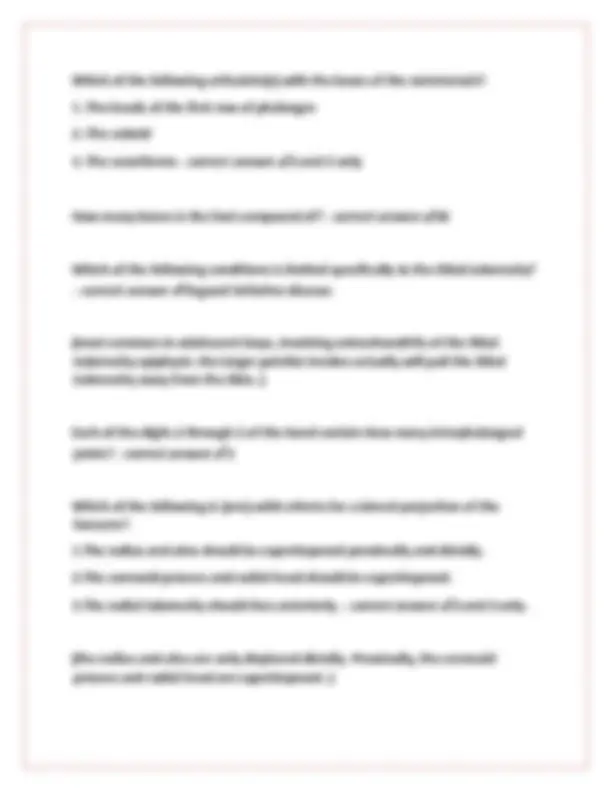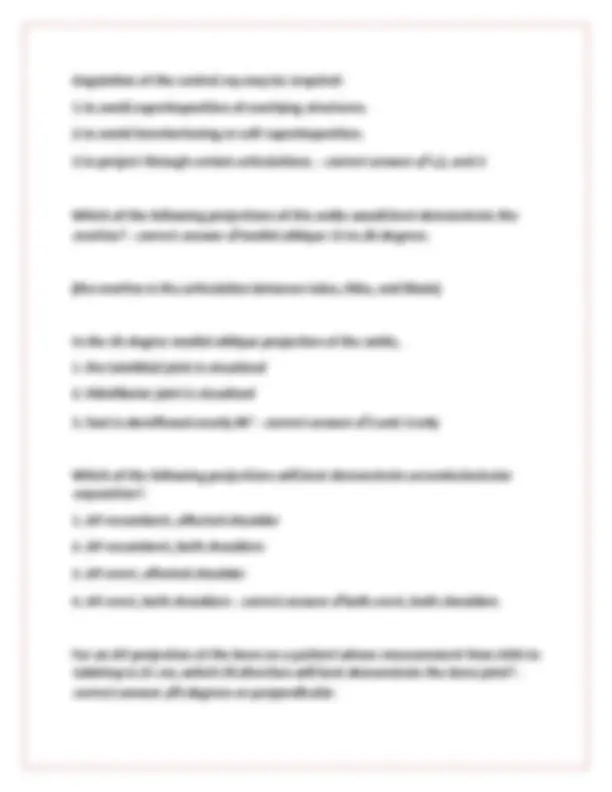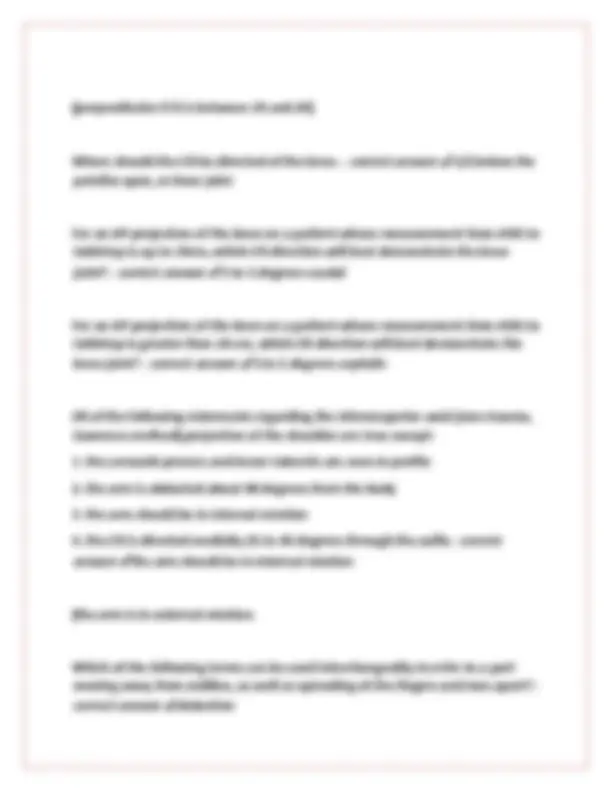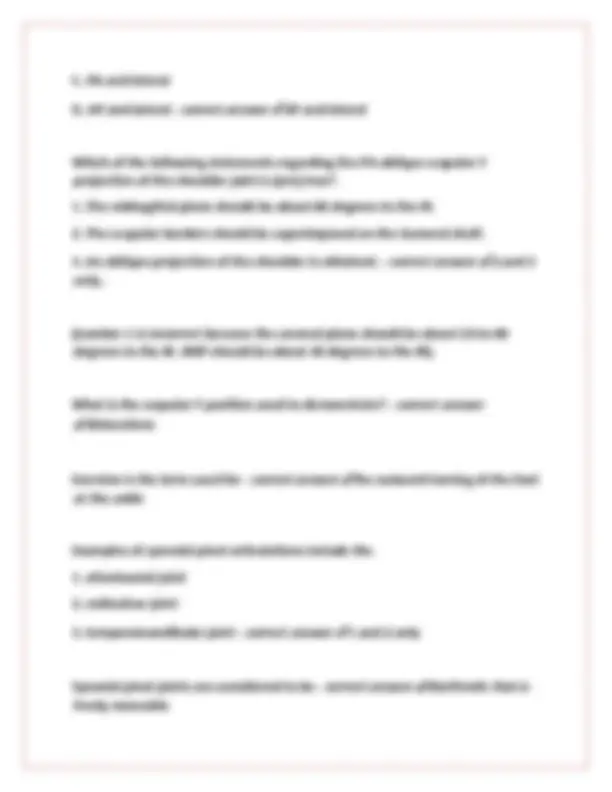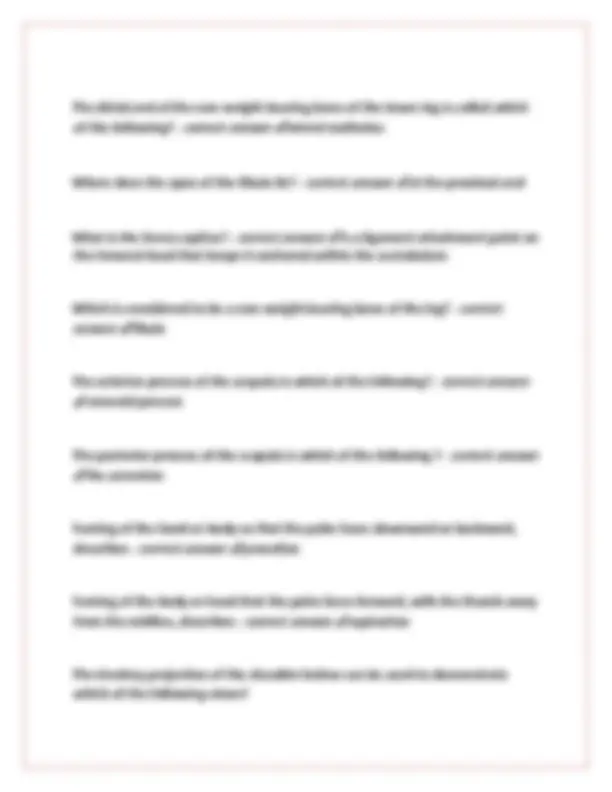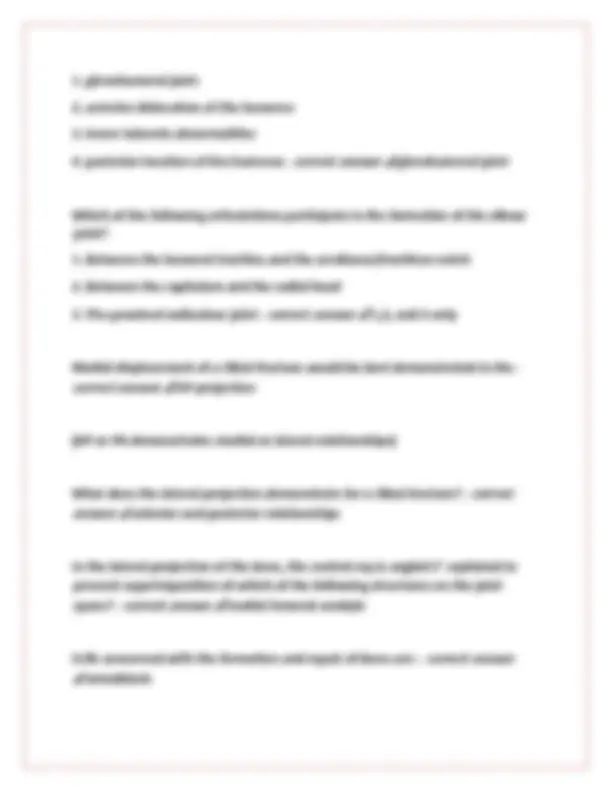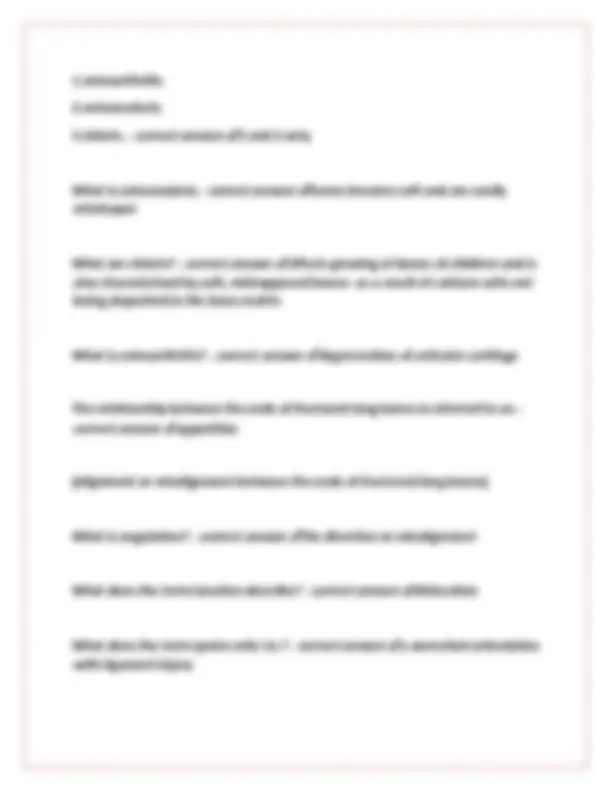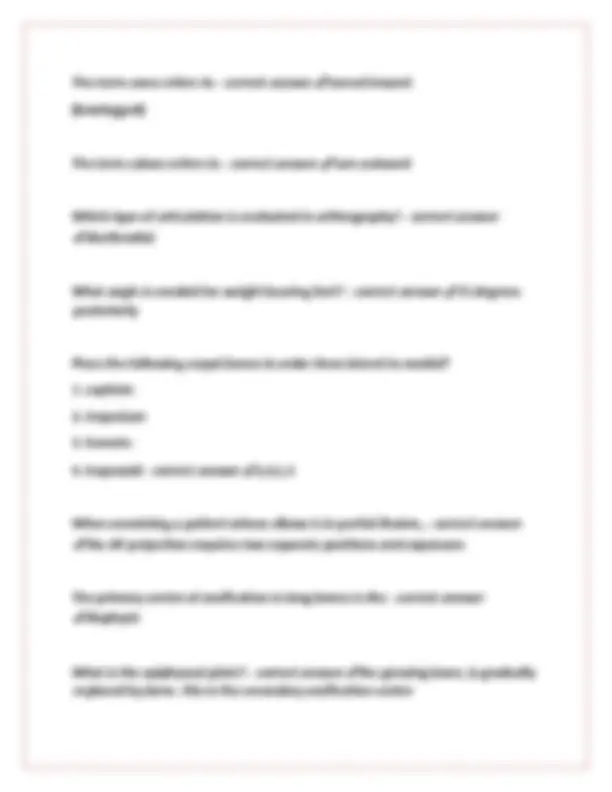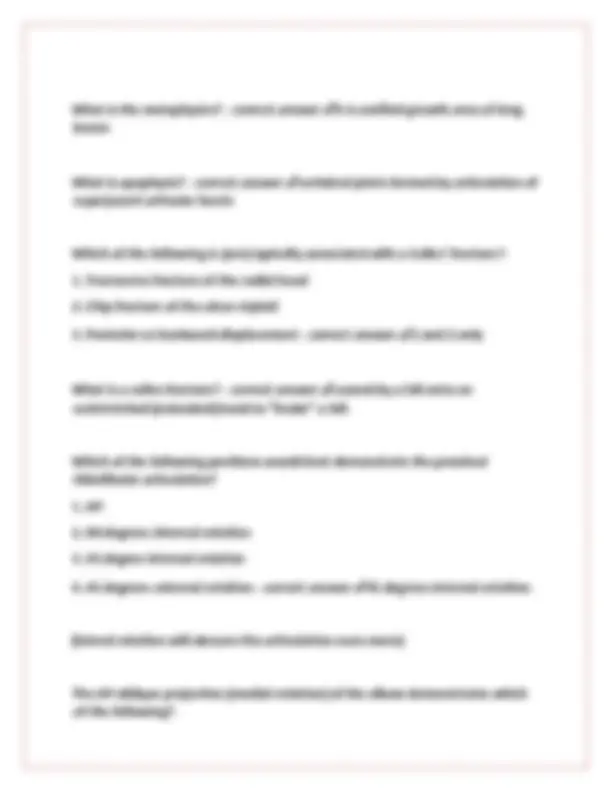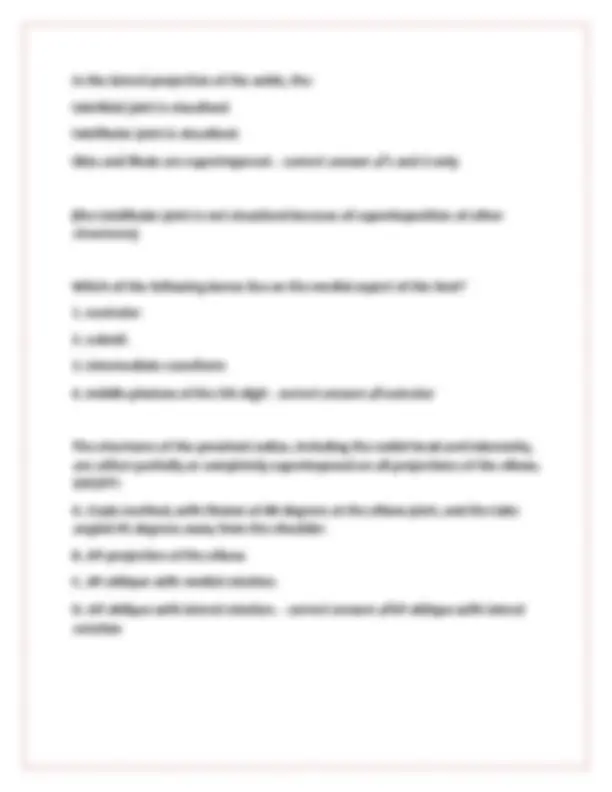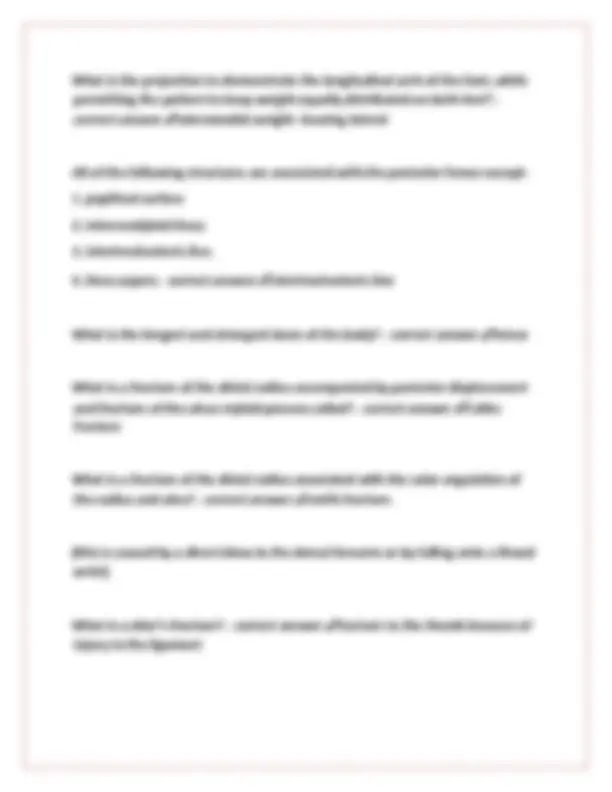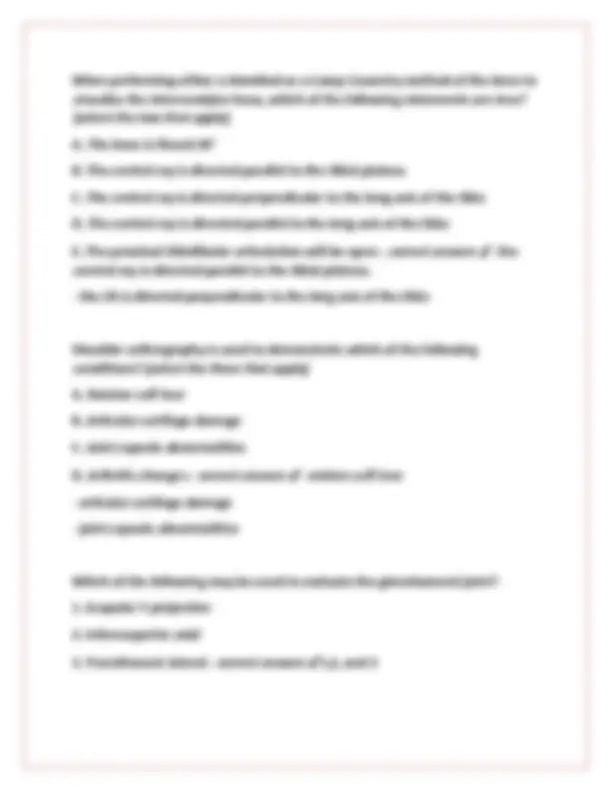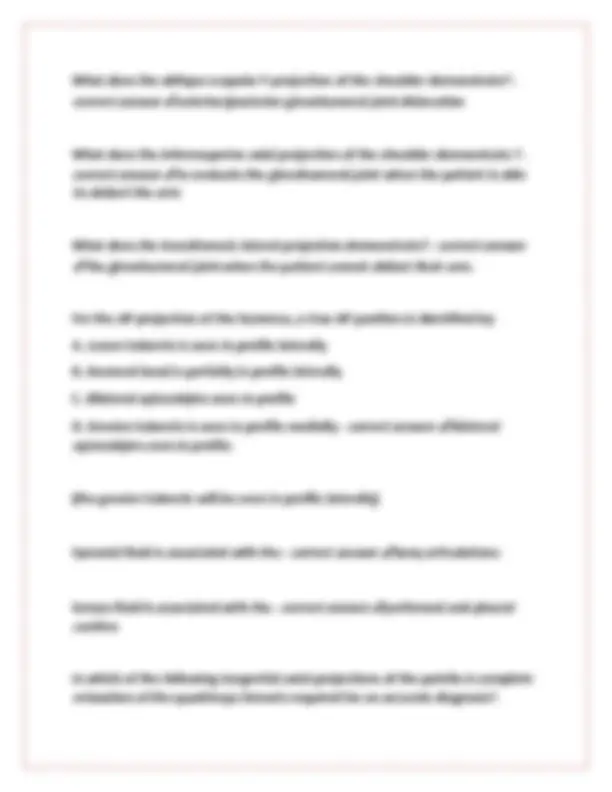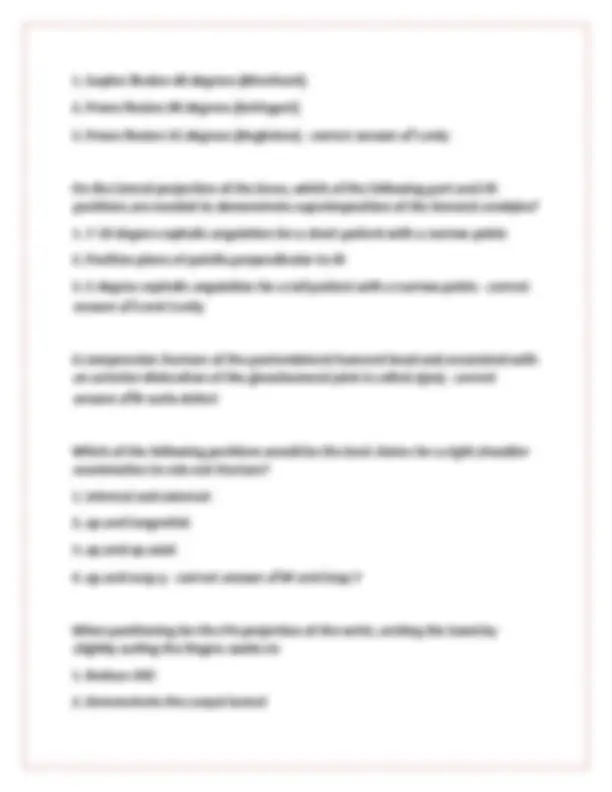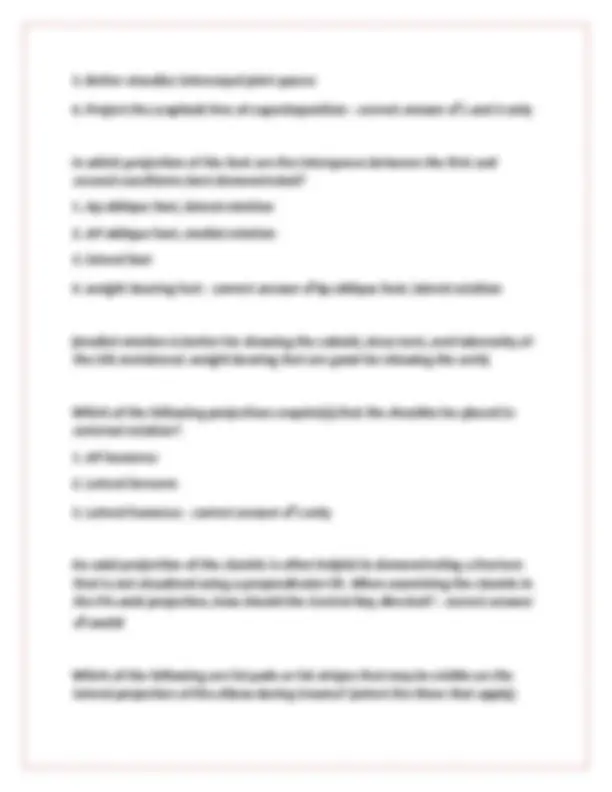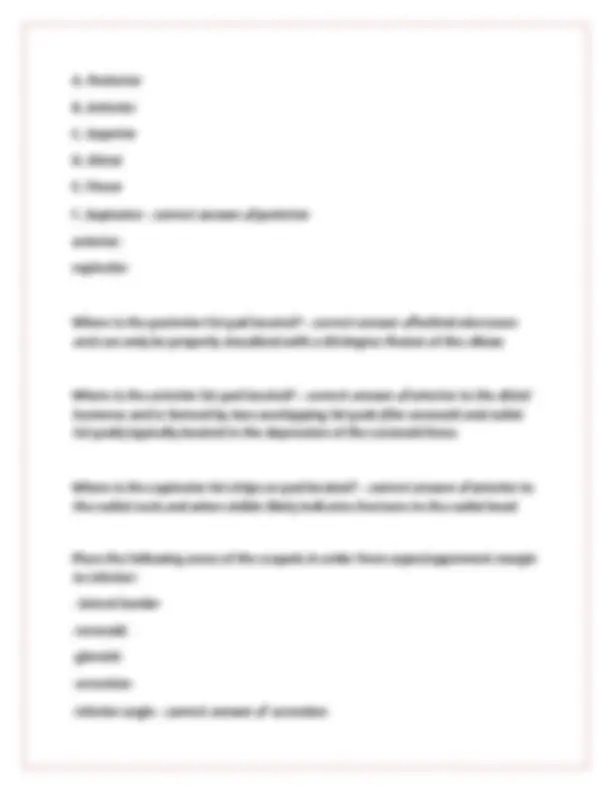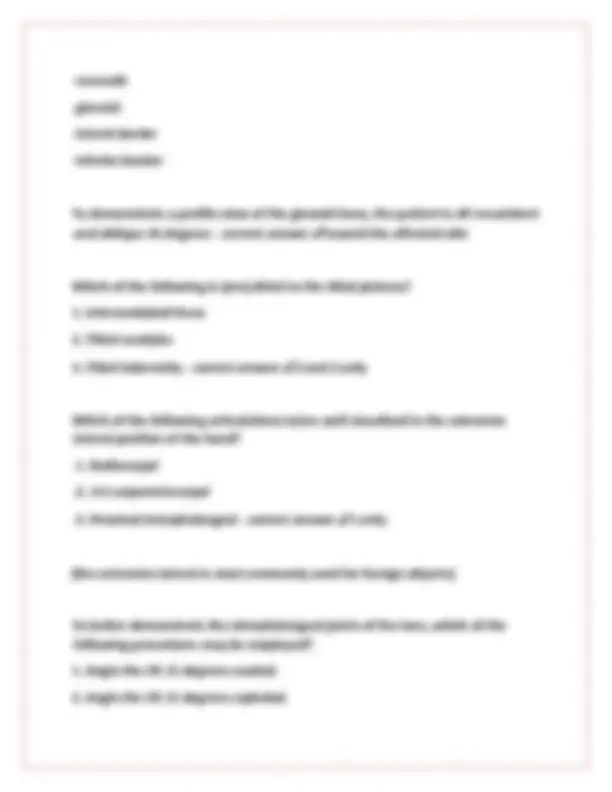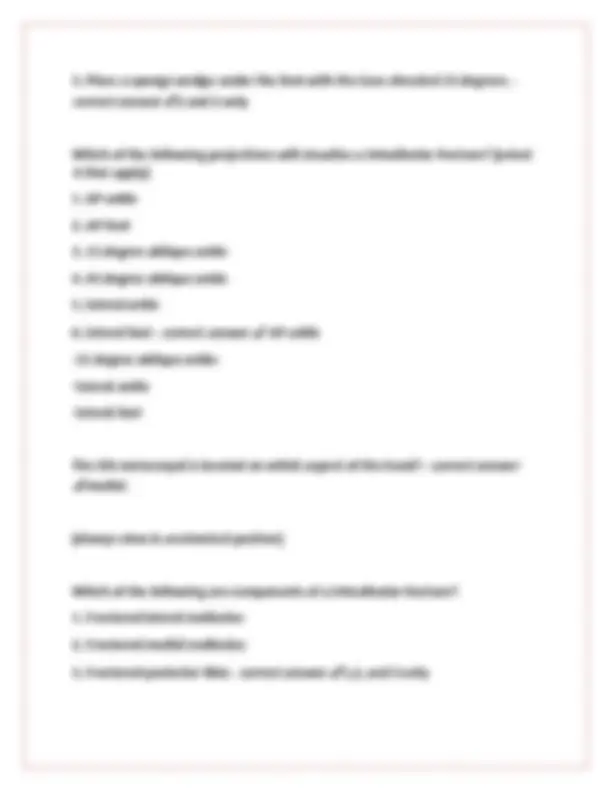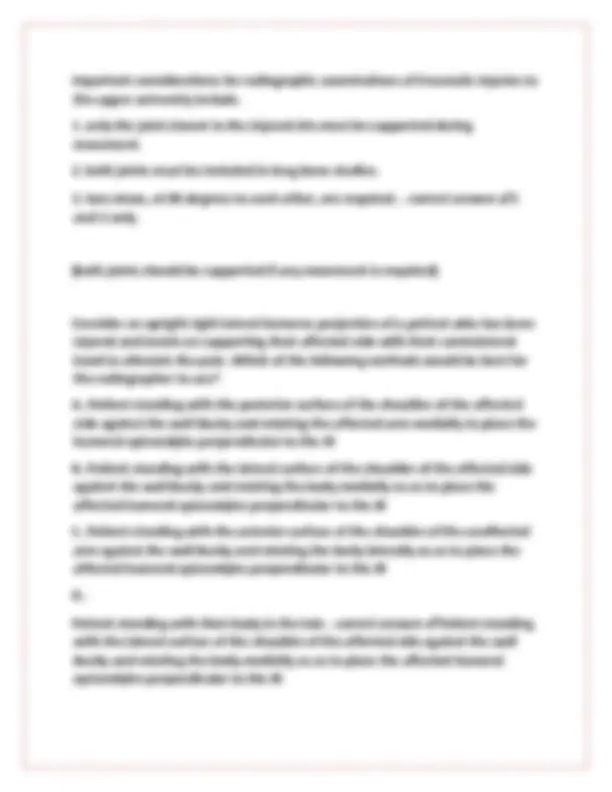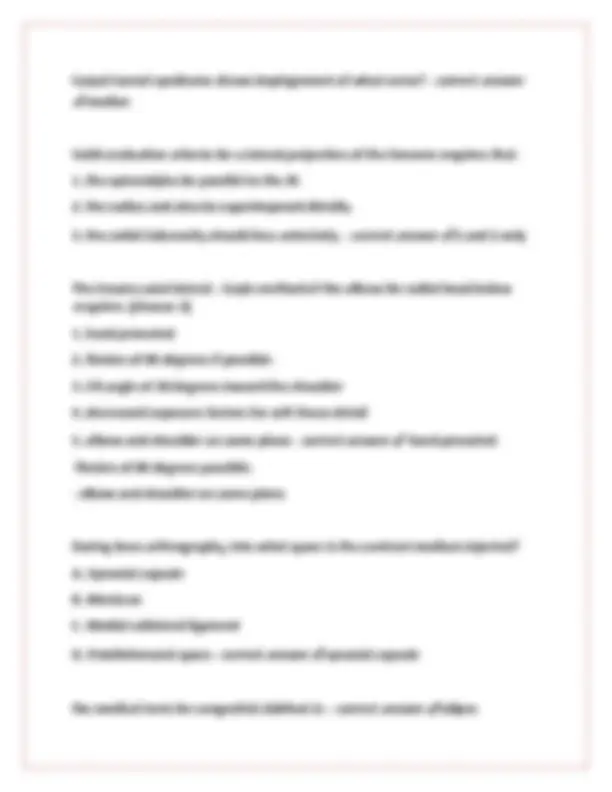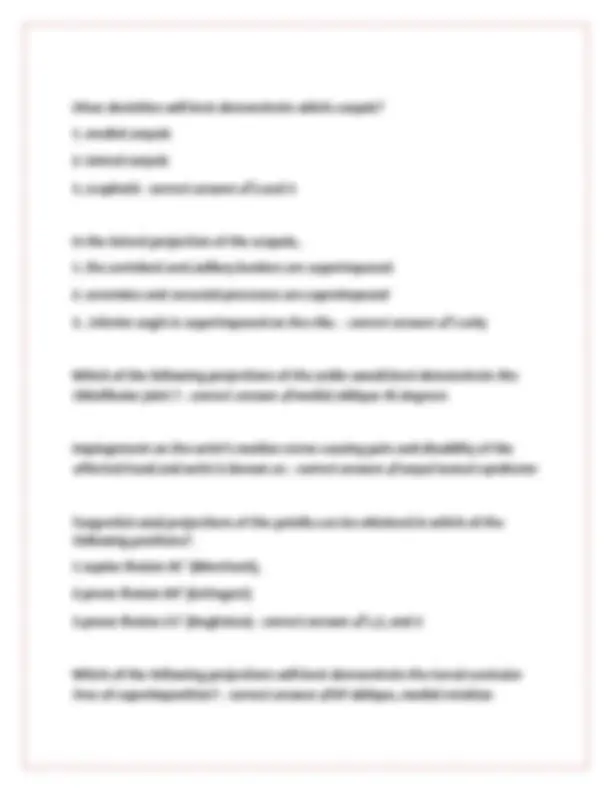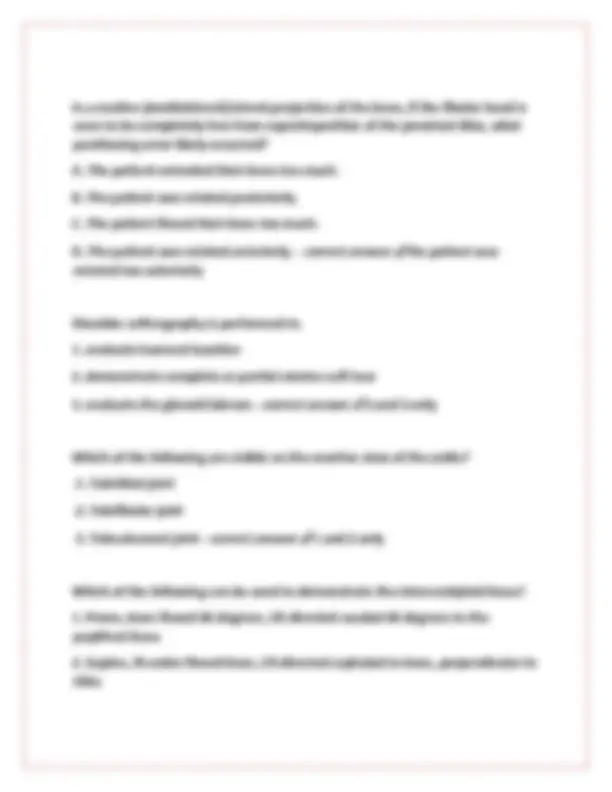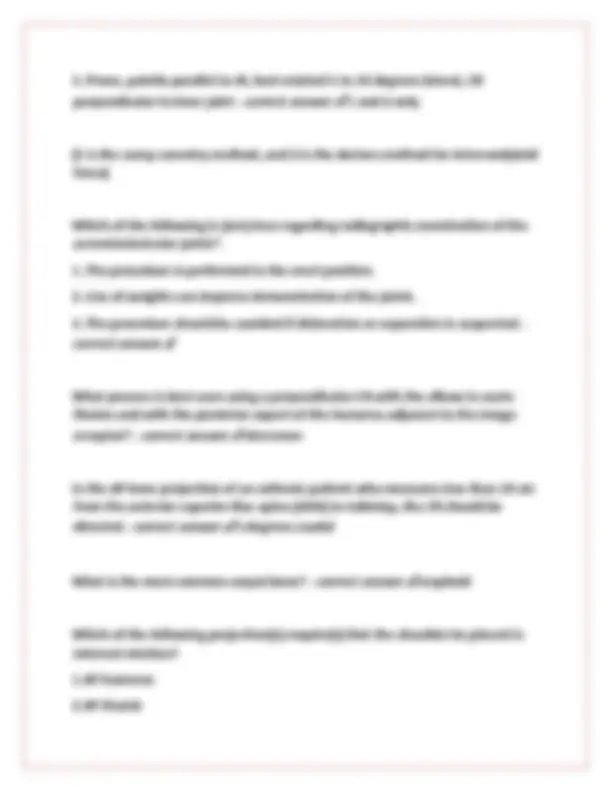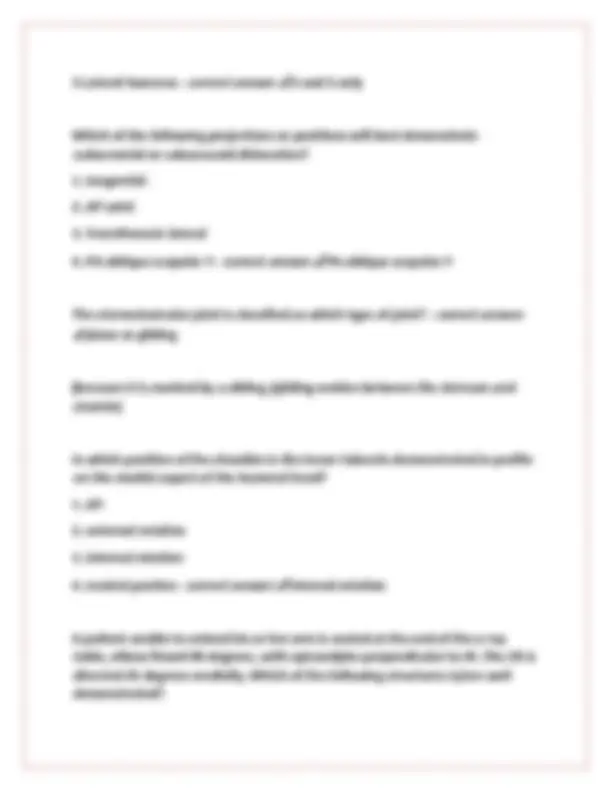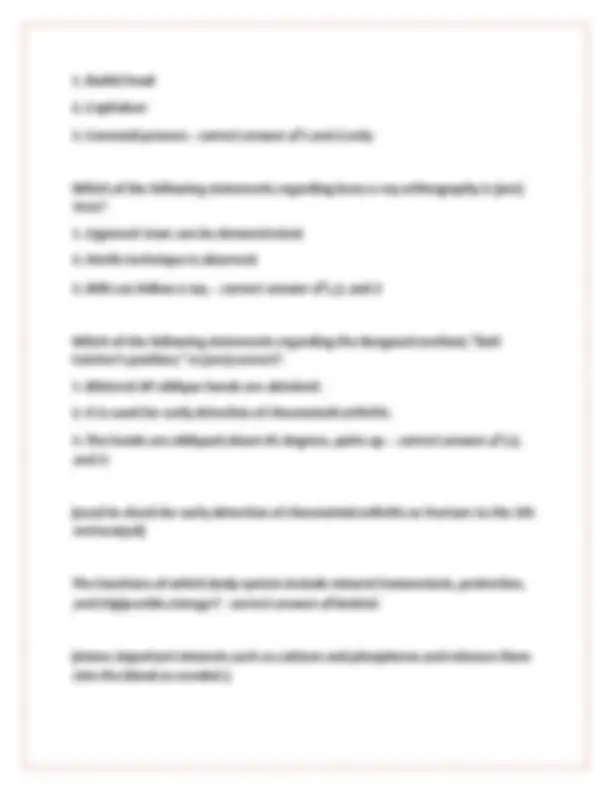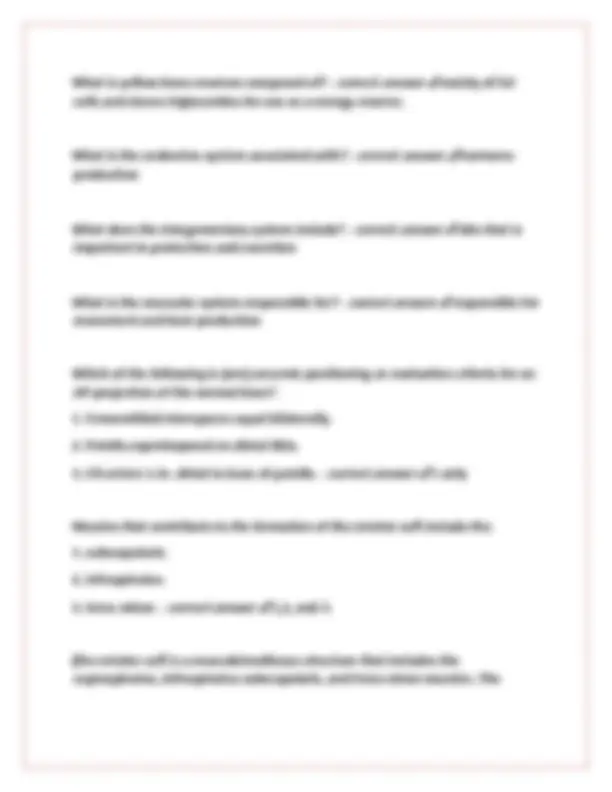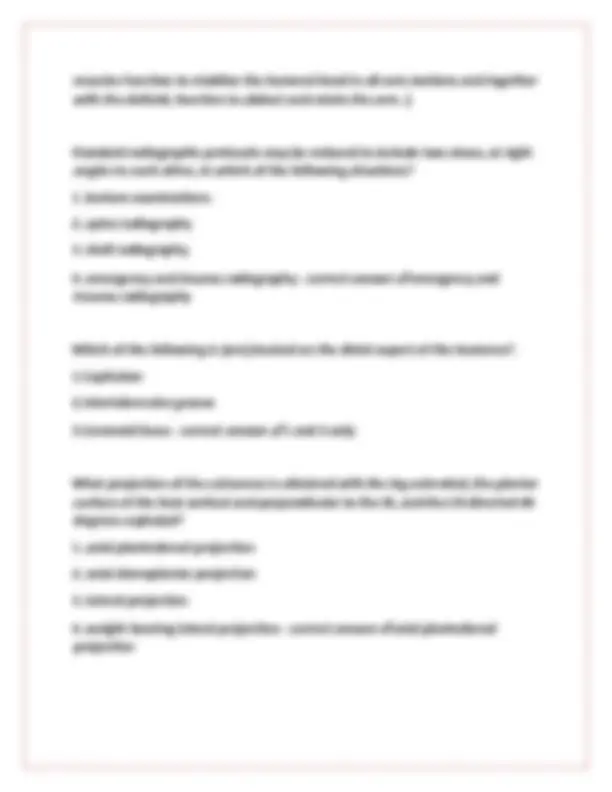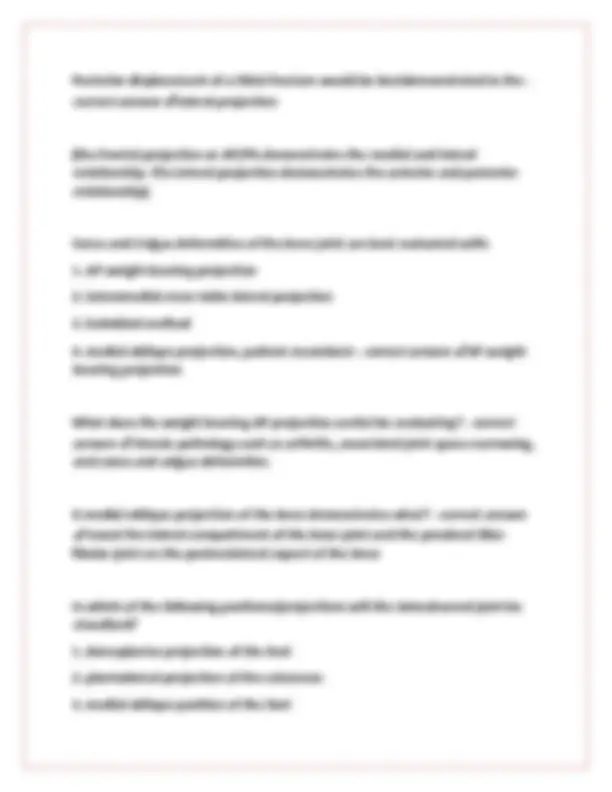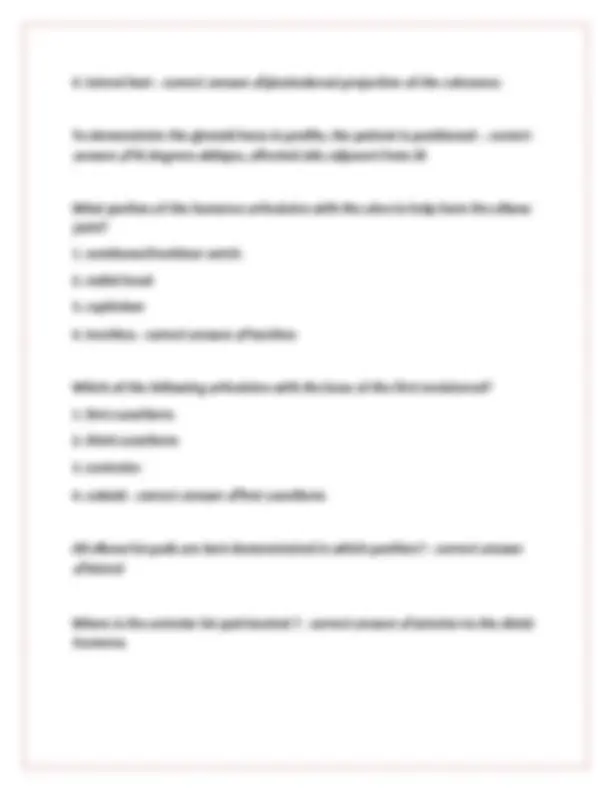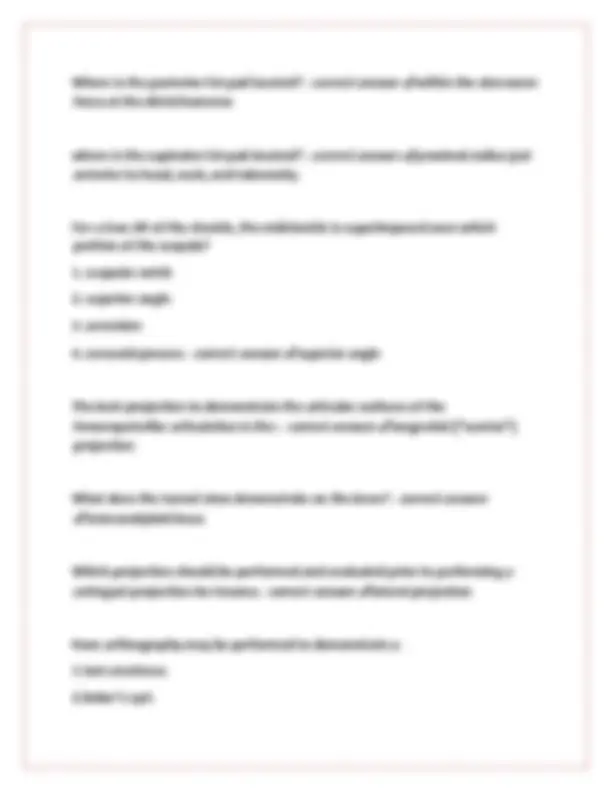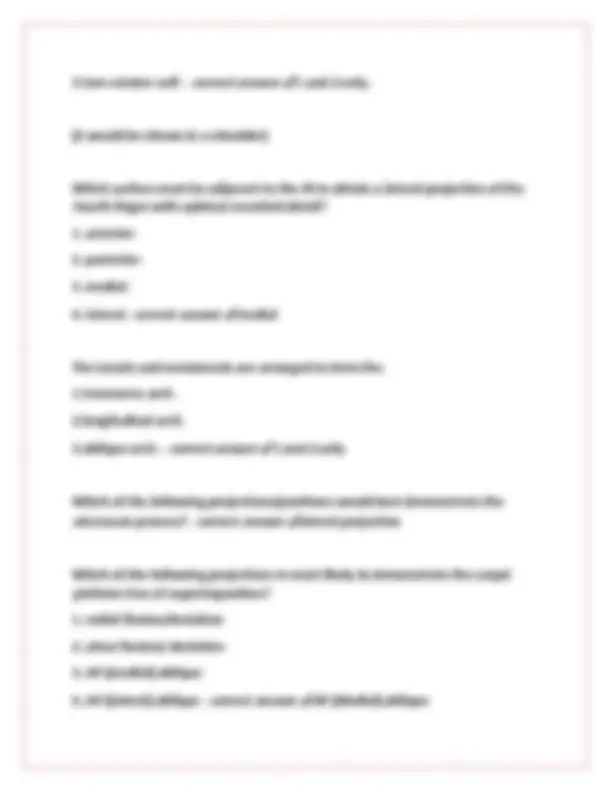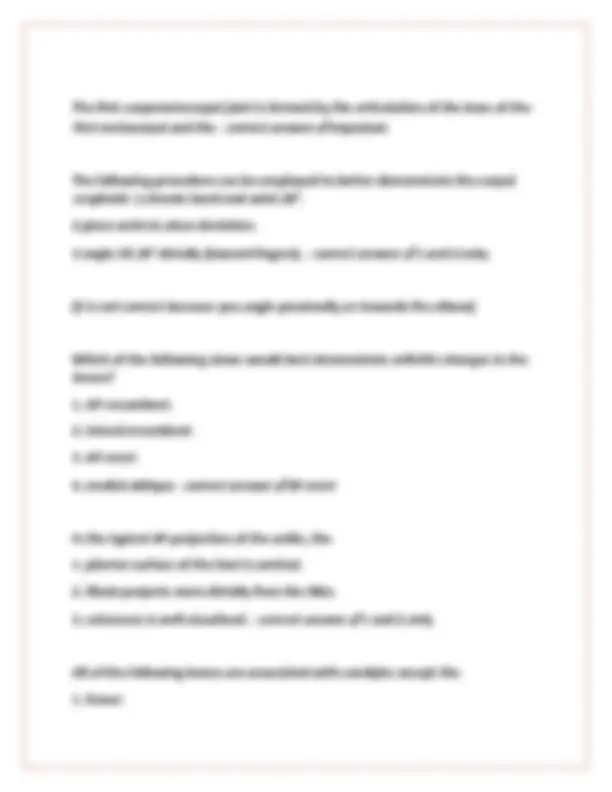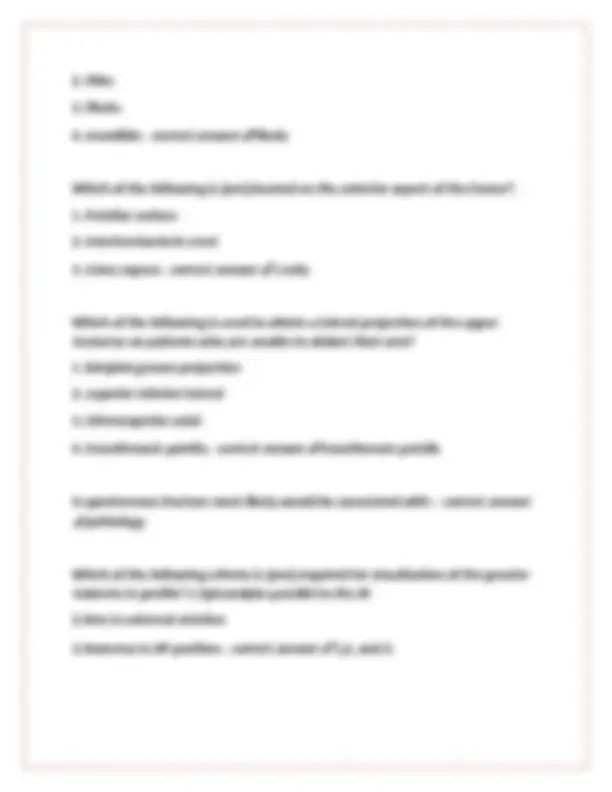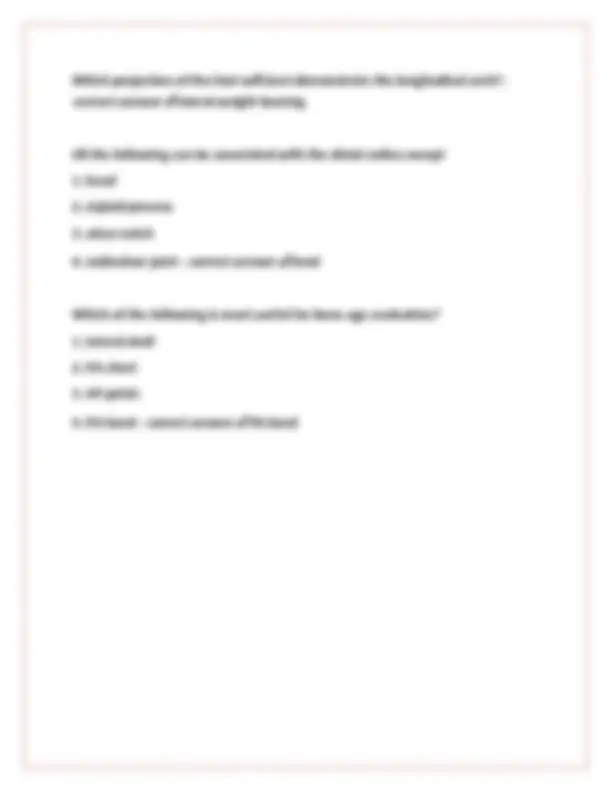Download ARRT extremities practice questions with correct answers and more Exams Nursing in PDF only on Docsity!
When |performing |the |lateral |humerus |with |the |mediolateral |projection, |which |of |the |following |does |not |apply?
- |position |patient |with |back |toward |IR
- |oblique |the |patient | 20 |to | 30 |degree, |to |bring |the |humerus |in |contact |with |IR
- |center |the |CR |midpoint |of |humerus
- |flex |elbow |to |position |epicondyles |perpendicular |to |IR. |- |correct |answer |✔position |the |patient |with |back |toward |the |IR. | (they |will |be |facing |the |IR |and |obliqued | 20 |to | 30 |degrees |from |PA) Proper |positioning |for |the |lateral |calcaneus |will |result |in:
- |Open |joint |space |between |calcaneus |and |cuboid
- |Superimposed |talar |domes
- |Lateral |malleolus |free |of |superimposition |- |correct |answer |✔ 1 |and | 2 |only | (it |will |result |in |open |joint |spaces |between |the |calcaneus |and |cuboid, |the |talus |and |calcaneus, |and |the |talus |and |the |navicular. |the |lateral |malleolus |will |partially |superimpose |the |distal |tibia |and |talus.) The |greater |tubercle |should |be |visualized |in |profile |in |which |of |the |following?
- |AP |shoulder, |external |rotation
- |AP |shoulder, |internal |rotation
- |AP |elbow
- |lateral |elbow |- |correct |answer |✔AP |shoulder, |external |rotation The |lesser |tubercle |should |be |visualized |with |what |projection |of |the |shoulder? |- |correct |answer |✔AP |shoulder, |internal |view |(this |places |the |humerus |in |a |true |lateral |position.) How |can |OID |be |reduced |for |a |PA |projection |of |the |wrist? |- |correct |answer |✔flex |the |metacarpophalangeal |joints How |is |a |hand |positioned |for |a |PA |projection |of |the |wrist? |- |correct |answer |✔hand |is |pronated |and |the |fingers |extended, |but |you |need |to |reduce |the |OID |by |flexing |the |MCP |joints What |is |radial |deviation? |- |correct |answer |✔it |is |flexing |the |that |brings |the |thumb |closer |to |the |radial |bone |of |the |forearm What |is |ulnar |deviation? |- |correct |answer |✔it |is |flexing |the |pinky |finger |closer |to |the |ulnar |bone |or |outside |of |the |forearm. Why |would |you |not |use |the |radial |deviation |position |for |looking |at |the |scaphoid? |- |correct |answer |✔it |foreshortens |it | radial |deviation |is |better |for |medial |carpals
Angulation |of |the |central |ray |may |be |required | 1.to |avoid |superimposition |of |overlying |structures. 2.to |avoid |foreshortening |or |self-superimposition. 3.to |project |through |certain |articulations. |- |correct |answer |✔1,2, |and | 3 Which |of |the |following |projections |of |the |ankle |would |best |demonstrate |the |mortise? |- |correct |answer |✔medial |oblique | 15 |to | 20 |degrees | (the |mortise |is |the |articulation |between |talus, |tibia, |and |fibula) In |the |45-degree |medial |oblique |projection |of |the |ankle, |
- |the |talotibial |joint |is |visualized
- |tibiofibular |joint |is |visualized
- |foot |is |dorsiflexed |nearly |90° |- |correct |answer |✔ 2 |and | 3 |only Which |of |the |following |projections |will |best |demonstrate |acromioclavicular |separation? |
- |AP |recumbent, |affected |shoulder
- |AP |recumbent, |both |shoulders
- |AP |erect, |affected |shoulder
- |AP |erect, |both |shoulders |- |correct |answer |✔both |erect, |both |shoulders For |an |AP |projection |of |the |knee |on |a |patient |whose |measurement |from |ASIS |to |tabletop |is | 21 |cm, |which |CR |direction |will |best |demonstrate |the |knee |joint? |- |correct |answer |✔ 0 |degrees |or |perpendicular |
(perpendicular |if |it |is |between | 19 |and |24) Where |should |the |CR |be |directed |of |the |knee. |- |correct |answer |✔1/2 |below |the |patellar |apex, |or |knee |joint For |an |AP |projection |of |the |knee |on |a |patient |whose |measurement |from |ASIS |to |tabletop |is |up |to |19cm, |which |CR |direction |will |best |demonstrate |the |knee |joint? |- |correct |answer |✔ 3 |to | 5 |degrees |caudal For |an |AP |projection |of |the |knee |on |a |patient |whose |measurement |from |ASIS |to |tabletop |is |greater |than | 24 |cm, |which |CR |direction |will |best |demonstrate |the |knee |joint? |- |correct |answer |✔ 3 |to | 5 |degrees |cephalic All |of |the |following |statements |regarding |the |inferosuperior |axial |(non |trauma, |lawrence |method) |projection |of |the |shoulder |are |true |except:
- |the |coracoid |process |and |lesser |tubercle |are |seen |in |profile
- |the |arm |is |abducted |about | 90 |degrees |from |the |body
- |the |arm |should |be |in |internal |rotation
- |the |CR |is |directed |medially | 25 |to | 30 |degrees |through |the |axilla |- |correct |answer |✔the |arm |should |be |in |internal |rotation (the |arm |is |in |external |rotation. Which |of |the |following |terms |can |be |used |interchangeably |to |refer |to |a |part |moving |away |from |midline, |as |well |as |spreading |of |the |fingers |and |toes |apart? |- |correct |answer |✔abduction
- |navicular |
- |cuboid |- |correct |answer |✔cuboid In |which |of |the |following |projections |is |the |talofibular |joint |best |demonstrated? |- |correct |answer |✔medial |oblique An |AP |oblique |(lateral |rotation) |of |the |elbow |demonstrates |which |of |the |following? |
- |Radial |head |free |of |superimposition
- |Capitulum |of |the |humerus
- |Olecranon |process |within |the |olecranon |fossa |- |correct |answer |✔ 1 |and | 2 |only | (the |medial |rotation |demonstrates |the |olecranon |process |within |the |oleceranon |fossa.) All |of |the |following |can |be |associated |with |the |distal |ulna |except
- |head
- |radioulnar |joint
- |styloid |process
- |trochlear |notch |- |correct |answer |✔trochlear |notch Which |of |the |following |is |most |likely |to |be |the |correct |routine |for |a |radiographic |examination |of |the |forearm? A. |PA |and |medial |oblique B. |AP |and |lateral |oblique
C. |PA |and |lateral D. |AP |and |lateral |- |correct |answer |✔AP |and |lateral Which |of |the |following |statements |regarding |the |PA |oblique |scapular |Y |projection |of |the |shoulder |joint |is |(are) |true? |
- |The |midsagittal |plane |should |be |about | 60 |degrees |to |the |IR.
- |The |scapular |borders |should |be |superimposed |on |the |humeral |shaft.
- |An |oblique |projection |of |the |shoulder |is |obtained. |- |correct |answer |✔ 2 |and | 3 |only. | (number | 1 |is |incorrect |because |the |coronal |plane |should |be |about | 50 |to | 60 |degrees |to |the |IR. |MSP |should |be |about | 30 |degrees |to |the |IR). What |is |the |scapular |Y |position |used |to |demonstrate? |- |correct |answer |✔dislocations Eversion |is |the |term |used |for |- |correct |answer |✔the |outward |turning |of |the |foot |at |the |ankle Examples |of |synovial |pivot |articulations |include |the |
- |atlantoaxial |joint
- |radioulnar |joint
- |temporomandibular |joint |- |correct |answer |✔ 1 |and | 2 |only Synovial |pivot |joints |are |considered |to |be |- |correct |answer |✔diarthrotic |that |is |freely |moveable
- |glenohumeral |joint |
- |anterior |dislocation |of |the |humerus
- |lesser |tubercle |abnormalities
- |posterior |location |of |the |humerus |- |correct |answer |✔glenohumeral |joint Which |of |the |following |articulations |participate |in |the |formation |of |the |elbow |joint? |
- |Between |the |humeral |trochlea |and |the |semilunar/trochlear |notch
- |Between |the |capitulum |and |the |radial |head
- |The |proximal |radioulnar |joint |- |correct |answer |✔1,2, |and | 3 |only Medial |displacement |of |a |tibial |fracture |would |be |best |demonstrated |in |the |- |correct |answer |✔AP |projection (AP |or |PA |demonstrates |medial |or |lateral |relationships) What |does |the |lateral |projection |demonstrate |for |a |tibial |fracture? |- |correct |answer |✔anterior |and |posterior |relationships In |the |lateral |projection |of |the |knee, |the |central |ray |is |angled |5° |cephalad |to |prevent |superimposition |of |which |of |the |following |structures |on |the |joint |space? |- |correct |answer |✔medial |femoral |condyle Cells |concerned |with |the |formation |and |repair |of |bone |are: |- |correct |answer |✔osteoblasts
Cells |concerned |with |the |breakdown |and |resorption |of |old |or |dead |bone |- |correct |answer |✔osteoclasts Benign |bony |tumor |is |- |correct |answer |✔osteoma A |microscopic |unit |of |compact |bone, |consisting |of |a |haversian |canal |and |its |surrounding |lamellae |- |correct |answer |✔osteon Which |of |the |following |fracture |classifications |describes |a |small |bony |fragment |pulled |from |a |bony |process |?
- |avulsion |fracture |
- |torus |fracture |
- |comminuted |fracture |
- |compound |fracture |- |correct |answer |✔avulsion |fracture Which |of |the |following |fracture |classifications |describes |one |where |the |bone |is |broken |splintered |into |pieces |?
- |avulsion |fracture |
- |torus |fracture |
- |comminuted |fracture |
- |compound |fracture |- |correct |answer |✔comminuted Which |of |the |following |fracture |classifications |describes |a |greenstick |fracture |with |one |cortex |buckled |and |the |other |intact |?
- |avulsion |fracture |
- |torus |fracture |
1.osteoarthritis. 2.osteomalacia. 3.rickets. |- |correct |answer |✔ 2 |and | 3 |only What |is |osteomalacia |- |correct |answer |✔bones |become |soft |and |are |easily |misshapen What |are |rickets? |- |correct |answer |✔affects |growing |of |bones |of |children |and |is |also |characterized |by |soft, |mishappened |bones- |as |a |result |of |calcium |salts |not |being |deposited |in |the |bone |matrix What |is |osteoarthritis? |- |correct |answer |✔degeneration |of |articular |cartilage The |relationship |between |the |ends |of |fractured |long |bones |is |referred |to |as: |- |correct |answer |✔apposition (alignment |or |misalignment |between |the |ends |of |fractured |long |bones) What |is |angulation? |- |correct |answer |✔the |direction |or |misalignment What |does |the |term |lunation |describe? |- |correct |answer |✔dislocation What |does |the |term |sprain |refer |to |? |- |correct |answer |✔a |wrenched |articulation |with |ligament |injury
The |term |varus |refers |to |- |correct |answer |✔turned |inward | (bowlegged) The |term |values |refers |to |- |correct |answer |✔turn |outward Which |type |of |articulation |is |evaluated |in |arthrography? |- |correct |answer |✔diarthrodial What |angle |is |needed |for |weight |bearing |feet? |- |correct |answer |✔ 15 |degrees |posteriorly Place |the |following |carpal |bones |in |order |from |lateral |to |medial?
- |capitate
- |trapezium
- |hamate |
- |trapezoid |- |correct |answer |✔2,4,1, When |examining |a |patient |whose |elbow |is |in |partial |flexion, |- |correct |answer |✔the |AP |projection |requires |two |separate |positions |and |exposures The |primary |center |of |ossification |in |long |bones |is |the |- |correct |answer |✔diaphysis What |is |the |epiphyseal |plate? |- |correct |answer |✔the |growing |bone, |is |gradually |replaced |by |bone. |this |is |the |secondary |ossification |center
1.Radial |head |free |of |superimposition 2.Olecranon |process |within |the |olecranon |fossa 3.Coronoid |process |free |of |superimposition |- |correct |answer |✔ 2 |and | 3 |only | (medial |oblique |projection |of |the |elbow |superimposes |the |radial |head |and |neck |on |the |proximal |ulna. |The |radial |head |is |projected |free |of |superimposition |in |the |AP |oblique |projection |lateral |rotation). With |the |patient |seated |at |the |end |of |the |x-ray |table, |elbow |flexed | 80 |degrees, |and |the |CR |directed | 45 |degrees |laterally |from |the |shoulder |to |the |elbow |joint, |which |of |the |following |structures |will |be |demonstrated |best? |- |correct |answer |✔coronoid |process The |secondary |center |of |ossification |in |long |bones |is |the |- |correct |answer |✔epiphysis In |the | 15 |degree |medial |oblique |projection |of |the |ankle |demonstrates |the |entire |
- |talofibular |joint |
- |tibiotalar |joint |
- |ankle |mortise |- |correct |answer |✔1,2, |and | 3 Which |of |the |following |projections |of |the |elbow |should |demonstrate |the |coronoid |process |free |of |superimposition |and |the |olecranon |process |within |the |olecranon |fossa? |- |correct |answer |✔medial |oblique
What |does |the |lateral |oblique |projection |of |the |elbow |demonstrate? |- |correct |answer |✔demonstrates |the |radial |head |free |of |ulnar |superimposition What |does |the |lateral |projection |of |elbow |demonstrate? |- |correct |answer |✔olecranon |process |in |profile What |does |the |medial |oblique |projection |of |the |elbow |demonstrate? |- |correct |answer |✔overlap |of |the |proximal |radius |and |ulna, |should |show |the |coronoid |process |free |of |superimposition |and |the |olecranon |process |within |the |olecranon |fossa All |of |the |following |can |be |associated |with |the |elbow |joint |except
- |the |capitulum
- |the |trochlea
- |the |tubercles |
- |the |epicondyles |- |correct |answer |✔the |tubercles Adult |orthoroentgenography, |or |radiographic |measurement |of |long |bones |of |an |upper |or |lower |extremity, |requires |which |of |the |following |accessories? |
- |Bell-Thompson |scale
- |Bucky |tray
- |Cannula |- |correct |answer |✔ 1 |and | 2 |only | (the |metallic |bell-thompson |scale |is |secured |to |the |x-ray |table |top |adjacent |to |the |limb |being |examined, |or |between |both |legs |if |examining |both.)
What |is |the |projection |to |demonstrate |the |longitudinal |arch |of |the |foot, |while |permitting |the |patient |to |keep |weight |equally |distributed |on |both |feet? |- |correct |answer |✔lateromedial |weight |-bearing |lateral All |of |the |following |structures |are |associated |with |the |posterior |femur |except:
- |popliteal |surface
- |intercondyloid |fossa
- |intertrochanteric |line |
- |linea |aspera |- |correct |answer |✔intertrochanteric |line What |is |the |longest |and |strongest |bone |of |the |body? |- |correct |answer |✔femur What |is |a |fracture |of |the |distal |radius |accompanied |by |posterior |displacement |and |fracture |of |the |ulnar |styloid |process |called? |- |correct |answer |✔Colles |fracture What |is |a |fracture |of |the |distal |radius |associated |with |the |solar |angulation |of |the |radius |and |ulna? |- |correct |answer |✔smith |fracture | (this |is |caused |by |a |direct |blow |to |the |dorsal |forearm |or |by |falling |onto |a |flexed |wrist) What |is |a |skier's |fracture? |- |correct |answer |✔fracture |to |the |thumb |because |of |injury |to |the |ligament
When |performing |either |a |Homblad |or |a |Camp-Coventry |method |of |the |knee |to |visualize |the |intercondylar |fossa, |which |of |the |following |statements |are |true? |(select |the |two |that |apply) A. |The |knee |is |flexed |30° B. |The |central |ray |is |directed |parallel |to |the |tibial |plateau C. |The |central |ray |is |directed |perpendicular |to |the |long |axis |of |the |tibia D. |The |central |ray |is |directed |parallel |to |the |long |axis |of |the |tibia E. |The |proximal |tibiofibular |articulation |will |be |open |- |correct |answer |✔- |the |central |ray |is |directed |parallel |to |the |tibial |plateau |
- |the |CR |is |directed |perpendicular |to |the |long |axis |of |the |tibia Shoulder |arthrography |is |used |to |demonstrate |which |of |the |following |conditions? |(select |the |three |that |apply) A. |Rotator |cuff |tear B. |Articular |cartilage |damage C. |Joint |capsule |abnormalities D. |Arthritic |changes |- |correct |answer |✔- |rotator |cuff |tear
- |articular |cartilage |damage
- |joint |capsule |abnormalities Which |of |the |following |may |be |used |to |evaluate |the |glenohumeral |joint? |
- |Scapular |Y |projection
- |Inferosuperior |axial
- |Transthoracic |lateral |- |correct |answer |✔1,2, |and | 3

